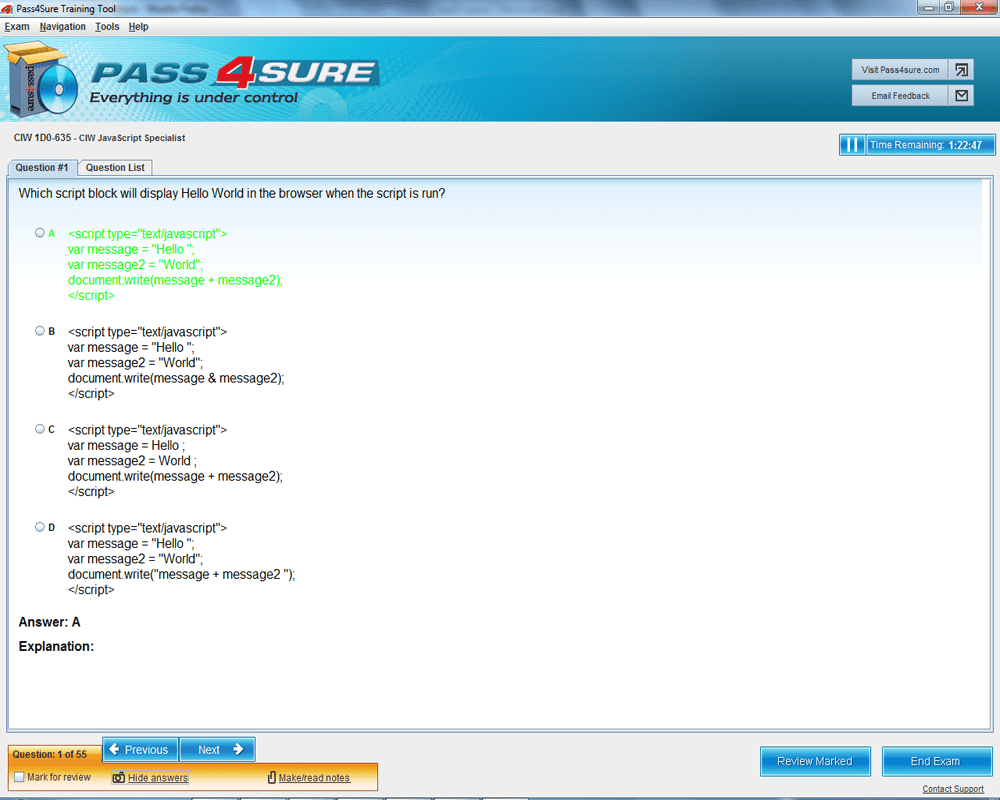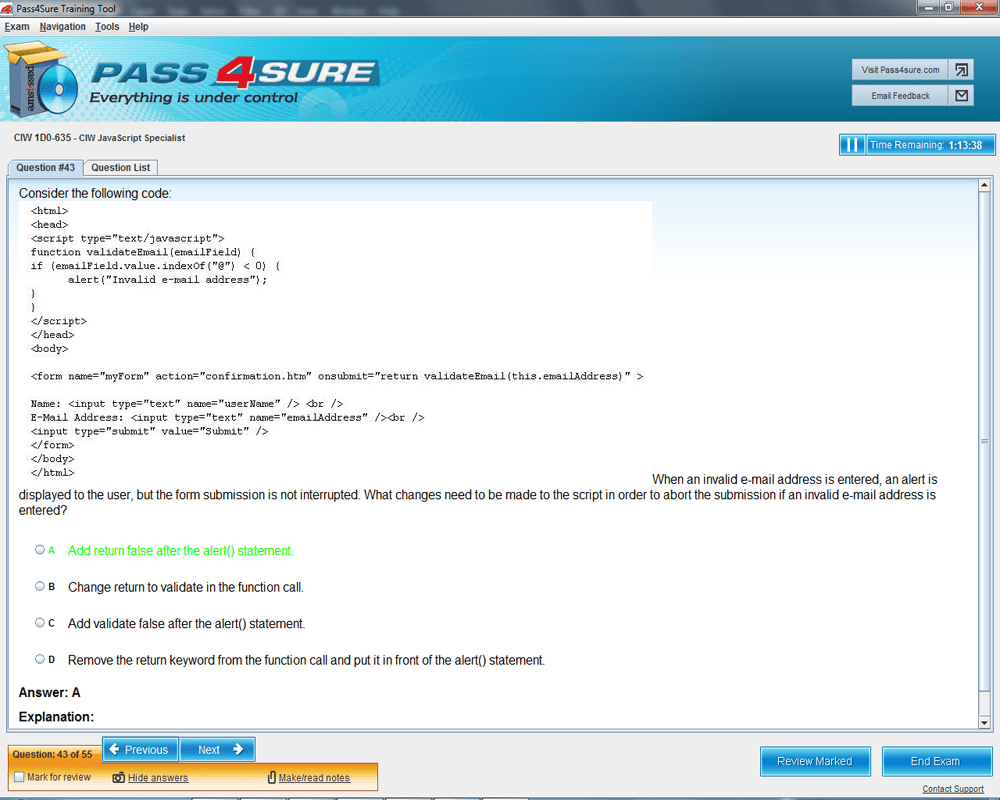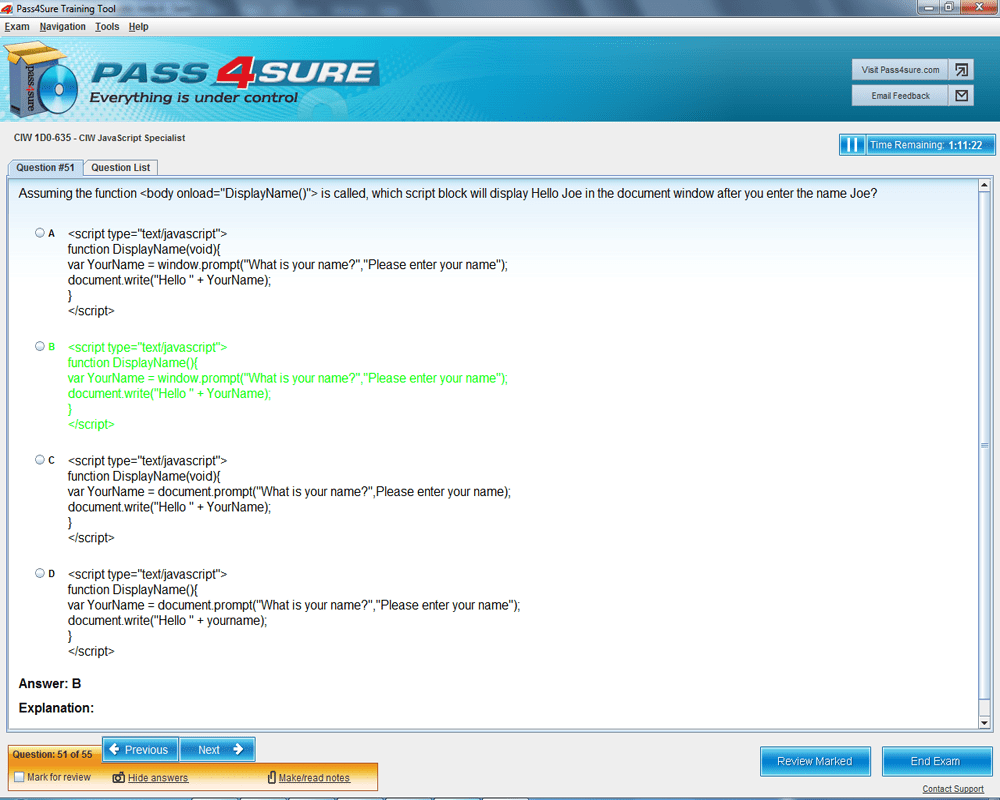Exam Code: 1D0-635
Exam Name: CIW JavaScript Specialist
Certification Provider: CIW
Corresponding Certifications: CIW JavaScript Specialist, CIW Web Development Professional
1D0-635 Exam Product Screenshots
Product Reviews
Instrumental in my 1D0-635 Exam Success
"Pass4sure practice questions were instrumental in my CIW 1D0-635 exam success. It was a concise and informative way to address the areas covered in the CIW JavaScript Specialist 1D0-635 exam. It was the only key for my exam preparation and I would recommend it to all.
Julia rack"
Don’t run after fake websites
"To clear the CIW 1D0-635 exam you need appropriate stuff and only Pass4sure can offer you that. I got certification by passing the 1D0-635 exam so my suggestion for you is that never run after fake websites and pass the CIW JavaScript Specialist 1D0-635 exam with Pass4sure’s help.
Robert"
Glad I found the best!
"I cannot even tell you how happy I am that I found Pass4sure for the 1D0-635 exam. It is like such a big burden has been lifted off my shoulders, and I can now relax and just focus on studying from the best resource for the CIW 1D0-635 exam. With Pass4sure, I could just focus on the testing engine and follow it from A to Z, without having to worry about finding more material or latest tools for the CIW JavaScript Specialist 1D0-635 exam, because Pass4sure is a complete package that gives you all you need. James Mallory"
Passed 1D0-635 exam at last!
"I am so happy and grateful to finally tell you all that I have passed the CIW 1D0-635 exam. The last couple of months have been very hard on me because I failed the CIW JavaScript Specialist 1D0-635 exam on my first attempt. However, I can say that it was not my fault because many people who relied on these course books and dumps like me have failed. The next time around, I was clever and did some research which pushed me towards Pass4sure. I am so happy to finally pass this exam! Terrence Macy"
Amazed at customer service
"When I first thought about using Pass4sure for the 1D0-635 exam, the last thing I expected was that they would have such a superior customer service. I am amazed at how much effort and thought they have put into their customer service as everyone is so helpful when it comes to questions about the CIW 1D0-635 exam. Pass4sure smoothed out all my tensions and questions for the CIW JavaScript Specialist 1D0-635 exam and helped me relax and focus on studying. I am a big fan of theirs as I am sure no other testing engine would have this customer service. Julia Greene"
Study Guide
"Pass4sure introduced a complete and comprehensive study guide for CIW JavaScript Specialist 1D0-635 exam. The study guide arranged my thoughts for the CIW 1D0-635 exam, so I passed the 1D0-635 exam with bright success. You must try the same guide it would be useful.
Karoline"
Most Suitable Material For Preparation
"If you want to pass the CIW JavaScript Specialist 1D0-635 exam, the material of Pass4sure, is most suitable for this purpose. With help of the material you can pass the 1D0-635 exam very easily. Pass4sure is a sure way for success in the CIW 1D0-635 exam.
Baptist"
Be Fully Prepared For The Exam
"I wanted to be certified by passing the CIW JavaScript Specialist 1D0-635 exam so I tried the products by Pass4sure. These products trained me for the 1D0-635 exam flawlessly. You can also use these products to be fully trained for the CIW 1D0-635 exam and I am sure that you will go through the exam easily.
Anna"
Got Certified In A Matter Of Days
"I got certified in a matter of days because Pass4sure presented amazing CIW 1D0-635 exam products to me. If you want to clear the 1D0-635 exam and get certified, then the most useful way is to use the products of Pass4sure, and ensure success in the CIW JavaScript Specialist 1D0-635 exam.
Diana"
Secure Success in 1D0-635 ; Bring Pass4sure!
"Your all troubles of passing CIW 1D0-635 can be sought out if you trust pass4sure by bringing it at home with its wonderful products. It gives such amazing CIW JavaScript Specialist 1D0-635 material that you will never be able to find it’s alternative in IT world. So, don’t be late. Andrew"
Frequently Asked Questions
How does your testing engine works?
Once download and installed on your PC, you can practise test questions, review your questions & answers using two different options 'practice exam' and 'virtual exam'. Virtual Exam - test yourself with exam questions with a time limit, as if you are taking exams in the Prometric or VUE testing centre. Practice exam - review exam questions one by one, see correct answers and explanations.
How can I get the products after purchase?
All products are available for download immediately from your Member's Area. Once you have made the payment, you will be transferred to Member's Area where you can login and download the products you have purchased to your computer.
How long can I use my product? Will it be valid forever?
Pass4sure products have a validity of 90 days from the date of purchase. This means that any updates to the products, including but not limited to new questions, or updates and changes by our editing team, will be automatically downloaded on to computer to make sure that you get latest exam prep materials during those 90 days.
Can I renew my product if when it's expired?
Yes, when the 90 days of your product validity are over, you have the option of renewing your expired products with a 30% discount. This can be done in your Member's Area.
Please note that you will not be able to use the product after it has expired if you don't renew it.
How often are the questions updated?
We always try to provide the latest pool of questions, Updates in the questions depend on the changes in actual pool of questions by different vendors. As soon as we know about the change in the exam question pool we try our best to update the products as fast as possible.
How many computers I can download Pass4sure software on?
You can download the Pass4sure products on the maximum number of 2 (two) computers or devices. If you need to use the software on more than two machines, you can purchase this option separately. Please email sales@pass4sure.com if you need to use more than 5 (five) computers.
What are the system requirements?
Minimum System Requirements:
- Windows XP or newer operating system
- Java Version 8 or newer
- 1+ GHz processor
- 1 GB Ram
- 50 MB available hard disk typically (products may vary)
What operating systems are supported by your Testing Engine software?
Our testing engine is supported by Windows. Andriod and IOS software is currently under development.







